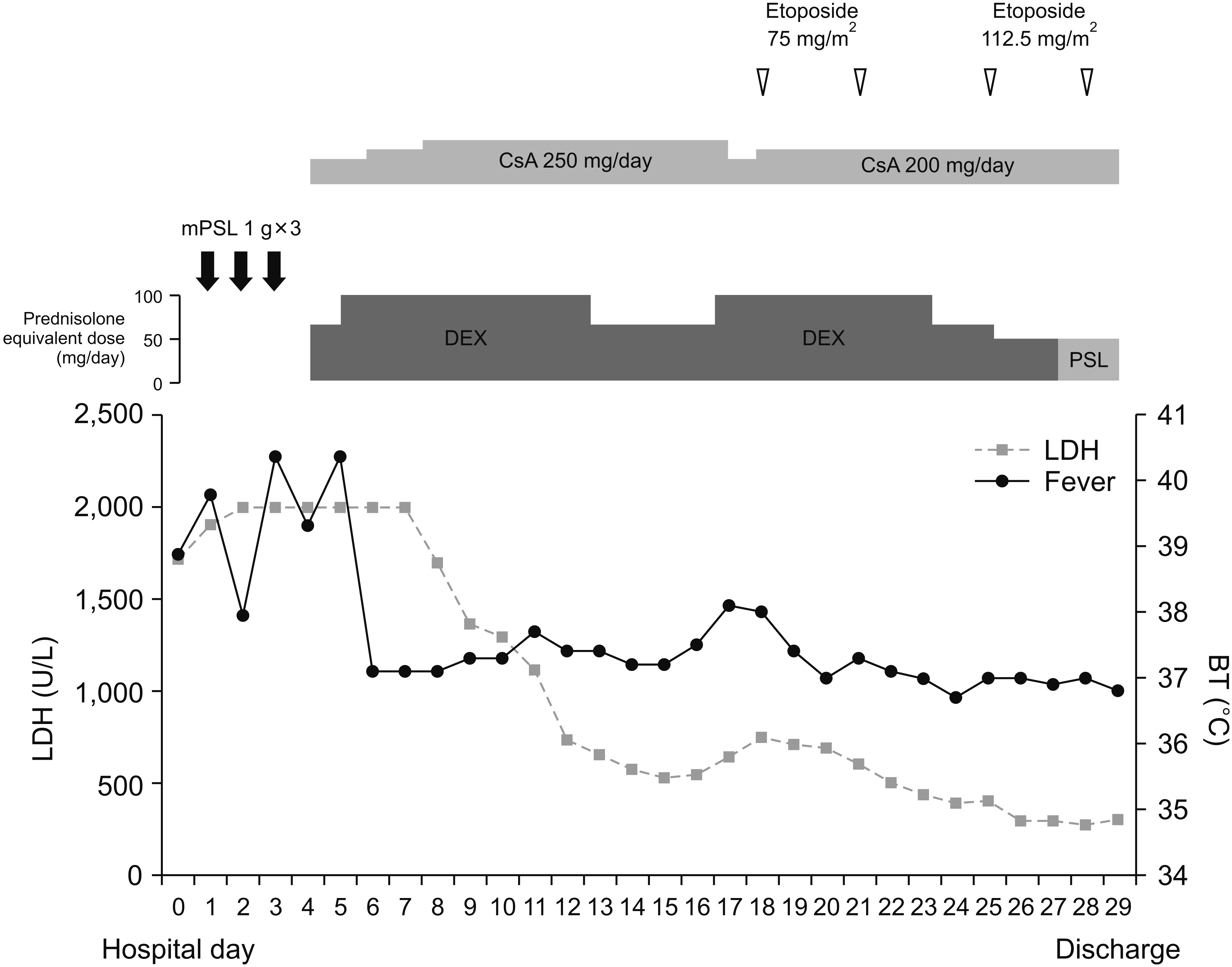1. Jamilloux Y, Gerfaud-Valentin M, Martinon F, Belot A, Henry T, Sève P. 2015; Pathogenesis of adult-onset Still's disease: new insights from the juvenile counterpart. Immunol Res. 61:53–62. DOI:
10.1007/s12026-014-8561-9. PMID:
25388963.

2. Banse C, Vittecoq O, Benhamou Y, Gauthier-Prieur M, Lequerré T, Lévesque H. 2013; Reactive macrophage activation syndrome possibly triggered by canakinumab in a patient with adult-onset Still's disease. Joint Bone Spine. 80:653–5. DOI:
10.1016/j.jbspin.2013.04.011. PMID:
23751410.

3. Shimizu M, Nakagishi Y, Kasai K, Yamasaki Y, Miyoshi M, Takei S, et al. 2012; Tocilizumab masks the clinical symptoms of systemic juvenile idiopathic arthritis-associated macrophage activation syndrome: the diagnostic significance of interleukin-18 and interleukin-6. Cytokine. 58:287–94. DOI:
10.1016/j.cyto.2012.02.006. PMID:
22398373.

4. Yokota S, Itoh Y, Morio T, Sumitomo N, Daimaru K, Minota S. 2015; Macrophage activation syndrome in patients with systemic juvenile idiopathic arthritis under treatment with tocilizumab. J Rheumatol. 42:712–22. DOI:
10.3899/jrheum.140288. PMID:
25684767.

5. Schulert GS, Minoia F, Bohnsack J, Cron RQ, Hashad S, KonÉ-Paut I, et al. 2018; Effect of biologic therapy on clinical and laboratory features of macrophage activation syndrome associated with systemic juvenile idiopathic arthritis. Arthritis Care Res (Hoboken). 70:409–19. DOI:
10.1002/acr.23277. PMID:
28499329.

6. Shimizu M, Mizuta M, Okamoto N, Yasumi T, Iwata N, Umebayashi H, et al. 2020; Tocilizumab modifies clinical and laboratory features of macrophage activation syndrome complicating systemic juvenile idiopathic arthritis. Pediatr Rheumatol Online J. 18:2. DOI:
10.1186/s12969-020-0399-1. PMID:
31924225. PMCID:
PMC6954608.

7. Irabu H, Shimizu M, Kaneko S, Inoue N, Mizuta M, Nakagishi Y, et al. 2020; Comparison of serum biomarkers for the diagnosis of macrophage activation syndrome complicating systemic juvenile idiopathic arthritis during tocilizumab therapy. Pediatr Res. 88:934–9. DOI:
10.1038/s41390-020-0843-4. PMID:
32184444.

8. Yamabe T, Ohmura SI, Uehara K, Naniwa T. 2021; Apr. 6. Macrophage activation syndrome in patients with adult-onset Still's disease under tocilizumab treatment: a single-center observational study. Mod Rheumatol. [Epub]. DOI:
10.1080/14397595.2021.1899565.

9. Yamaguchi M, Ohta A, Tsunematsu T, Kasukawa R, Mizushima Y, Kashiwagi H, et al. 1992; Preliminary criteria for classification of adult Still's disease. J Rheumatol. 19:424–30.
10. Henter JI, Horne A, Aricó M, Egeler RM, Filipovich AH, Imashuku S, et al. 2007; HLH-2004: diagnostic and therapeutic guidelines for hemophagocytic lymphohistiocytosis. Pediatr Blood Cancer. 48:124–31. DOI:
10.1002/pbc.21039. PMID:
16937360.

11. Martini A, Ravelli A, Avcin T, Beresford MW, Burgos-Vargas R, Cuttica R, et al. 2019; Toward new classification criteria for juvenile idiopathic arthritis: first steps, Pediatric Rheumatology International Trials Organization international consensus. J Rheumatol. 46:190–7. DOI:
10.3899/jrheum.180168. PMID:
30275259.

12. Ravelli A, Minoia F, Davì S, Horne A, Bovis F, Pistorio A, et al. 2016; 2016 classification criteria for macrophage activation syndrome complicating systemic juvenile idiopathic arthritis: a European League Against Rheumatism/American College of Rheumatology/Paediatric Rheumatology Inter-national Trials Organisation collaborative initiative. Arthritis Rheumatol. 68:566–76. DOI:
10.1002/art.39332. PMID:
26314788.
13. Wang R, Li T, Ye S, Tan W, Zhao C, Li Y, et al. 2020; Macrophage activation syndrome associated with adult-onset Still's disease: a multicenter retrospective analysis. Clin Rheumatol. 39:2379–86. DOI:
10.1007/s10067-020-04949-0. PMID:
32130578.

14. Iemoli E, Piconi S, Fusi A, Borgonovo L, Borelli M, Trabattoni D. 2010; Immunological effects of omalizumab in chronic urticaria: a case report. J Investig Allergol Clin Immunol. 20:252–4.
15. La Rosée P, Horne A, Hines M, von Bahr Greenwood T, Machowicz R, Berliner N, et al. 2019; Recommendations for the management of hemophagocytic lymphohistiocytosis in adults. Blood. 133:2465–77. DOI:
10.1182/blood.2018894618. PMID:
30992265.






 PDF
PDF Citation
Citation Print
Print



 XML Download
XML Download